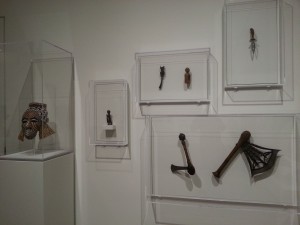All That Glitters…
Art Museums Making It Art
I shall not today attempt further to define the kinds of material I understand to be embraced within that shorthand description, and perhaps I could never succeed in intelligibly doing so. But I know it when I see it…1
When Justice Potter Stewart penned those word in a 1964 concurring opinion on a case involving a motion picture, he had in mind pornography. Today the statement could easily apply to a certain attitude held by many people toward art, unaware as they are of the vulnerability to manipulation of their belief.
Attempting to define the “kinds of material embraced within that shorthand description” art has been a favorite pastime of deep thinkers from at least as far back as Plato, with neuroscientists recently adding their voices to the cacophony.2 When creative types stepped outside accepted norms (as they are wont to do), they further complicated this age-old struggle to determine the nature of art.
The terminology problem achieved critical mass when in April 1917 Marcel Duchamp–pushing the limits of the Society of Independent Artists’ policy of accepting all proffered objects–presented to its hanging committee a urinal he purchased from the J. L. Mott Iron Works company, having affixed to it the signature “R. Mutt” and anointed it Fountain.3 In another sphere of activity but also during the early part of the twentieth century, a boom in archaeological digs coupled with a proliferation of publications for a general audience introduced yet another set of objects for consideration as art.4 Contemporaneously, indigenous works from Africa began to migrate from ethnic collections to art galleries,5 setting in motion a reevaluation of comparable items brought from analogous cultures elsewhere.
The legacy of these developments can be found today gracing the interiors of art museums, where (among other factors) a simple change in accompanying label can alter the meaning of an object on display.6
![Theaster Gates, In Case of Race Riot II (2011, wood, metal and hoses, 32 x 25 x 6 in [81.3 x 63.5 x 15.2 cm]). Brooklyn Museum, New York.](http://www.deborahfeller.com/news-and-views/wp-content/uploads/2015/06/T-Gates-In-Case-of-Race-Riot-II-237x300.jpg)
Theaster Gates, In Case of Race Riot II (2011, wood, metal and hoses, 32 x 25 x 6 in [81.3 x 63.5 x 15.2 cm]). Brooklyn Museum, New York.
Instead, the explanatory label begins with a name–Theaster Gates, adds a title–In Case of Race Riot II, and includes a list of materials used in its assemblage. The story of the piece follows. The viewer is cued to consider the object a work of art by the box that frames it, the label that describes it, the spotlighting that illuminates it, and the art museum that placed it in the company of other similarly designated pieces. The power of this image to evoke an emotional response in beholders is enhanced by any personal recollections of the civil rights events of the 1960s to which it refers. Such reminiscences are encouraged by the declared theme of the gallery, “A Nation Divided.”
Clearly art museums do far more than simply collect and display artwork. These structures have been variously described as: ritual spaces ”designed to induce in viewers an intense absorption with artistic spirits of the past;”7 “philosophical instruments” that “propose taxonomies of the world” and “encourage aesthetic engagement with their contents,”8 “optical instrument[s] for the refracting of society;”9 places for the “staging of objects relative to other objects in a plotting system that transforms juxtaposition and simple succession into an evolutionary narrative of influence and descent…a configured story culminating in our present;”10 guarantors of the “artificial longevity” of ultimately perishable commodities,11 which attempt to “contradict the irreversibility of time and its end result in death;”12 and–most relevant to this exploration–an institution with the purpose of teaching “the difference between pencils and works of art”13 or more generally, “works of art and mere real things.”14
![Marcel Duchamp, In Advance of the Broken Arm (1964 [prototype, 1915], wood and galvanized-iron snow shovel, 52 in [132 cm] high). Museum of Modern Art, New York.](http://www.deborahfeller.com/news-and-views/wp-content/uploads/2015/06/Duchamp-Snow-Shovel-225x300.jpg)
Marcel Duchamp, In Advance of the Broken Arm (1964 [prototype, 1915], wood and galvanized-iron snow shovel, 52 in [132 cm] high). Museum of Modern Art, New York.
The heights of absurdity possible when artists (or art museums or the art market) become sole arbiters of an object’s artistic status found dramatic expression in 1998 when Alan Alda played Marc, an outraged skeptic in the Broadway production of Art. When Marc’s longtime friend proudly displayed the latest (and very expensive) addition to his modern art collection–a totally white canvas, the ensuing conflict over the nature of art (which included a third pal as intermediary) threatened to derail a fifteen-year friendship.17 Such is the passion invoked by the question, “What is art?”
An alternative way of posing the question–“When is art?”18–underscores the importance of context. One can designate as art a found, constructed, fabricated or handcrafted work, but its definitive determination as such seems to rely on its ultimate resting place. Art museums display art. Natural history museums house ethnographic collections and archaeological finds. Design museums celebrate human’s ingenuity. Large enough encyclopedic museums show it all. Or so it would seem.
The visitor to a Surrealism exhibit, encountering Duchamp’s snow shovel suspended in the museum gallery, can’t see how it differs from the one that leans against the wall in a suburban garage. Titled In Advance of the Broken Arm, the readymade proves that “a thing may function as a work of art at some times and not at others.”19
![Radio Compass Loop Antenna Housing (c. 1940, rag-filled Bakelite and metal, 13¾ x 91/16 x 26⅜ in [35 x 23 x 67 cm]). Smithsonian Design Museum, Cooper Hewitt, New York.](http://www.deborahfeller.com/news-and-views/wp-content/uploads/2015/06/Radar-Housing-Cooper-Hewitt-300x225.jpg)
Radio Compass Loop Antenna Housing (c. 1940, rag-filled Bakelite and metal, 13¾ x 91/16 x 26⅜ in [35 x 23 x 67 cm]). Smithsonian Design Museum, Cooper Hewitt, New York.
![Constantin Brancusi, Sleeping Muse II (c. 1926, polished bronze, 6½ x 7½ x 11½ in [16.5 x 19.1 x 29.2 cm]). Harvard Museums, Cambridge, Massachusetts.](http://www.deborahfeller.com/news-and-views/wp-content/uploads/2015/06/Brancusi-Sleeping-Muse-self-portrait-300x225.jpg)
Constantin Brancusi, Sleeping Muse II (c. 1926, polished bronze, 6½ x 7½ x 11½ in [16.5 x 19.1 x 29.2 cm]). Harvard Museums, Cambridge, Massachusetts.
![Henry Dreyfuss, Design for Acratherm Gauge (1943, brush and gouache, graphite, pen and black ink on illustration board, 11 × 8½ in [27.9 × 21.6 cm]). Smithsonian Design Museum, Cooper Hewitt, New York.](http://www.deborahfeller.com/news-and-views/wp-content/uploads/2015/06/Cooper-Hewitt-Design-for-Acatherm-Gauge-225x300.jpg)
Henry Dreyfuss, Design for Acratherm Gauge (1943, brush and gouache, graphite, pen and black ink on illustration board, 11 × 8½ in [27.9 × 21.6 cm]). Smithsonian Design Museum, Cooper Hewitt, New York.
![Walter Launt Palmer, Painting, Interior of Henry de Forest House (1878, oil on canvas mounted on canvas, 24⅛ x 18 in [61.3 x 45.7 cm]). Smithsonian Design Museum, Cooper Hewitt, New York.](http://www.deborahfeller.com/news-and-views/wp-content/uploads/2015/06/Cooper-Hewitt-Painting-Interior-of-de-Forest-House-225x300.jpg)
Walter Launt Palmer, Painting, Interior of Henry de Forest House (1878, oil on canvas mounted on canvas, 24⅛ x 18 in [61.3 x 45.7 cm]). Smithsonian Design Museum, Cooper Hewitt, New York.
Upstairs at the same design museum, great pains have been taken to ensure that visitors don’t mistake a bona fide artwork for an architect’s rendering of a domestic interior. The first word on the label for Walter Launt Palmer’s painting of the Interior of Henry de Forest House (1878) is “painting.”
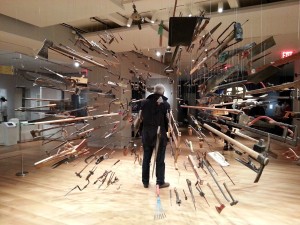
Displayed on “Tools” floor of Cooper Hewitt. Damián Ortega, Controller of the Universe (2007, found tools and wire, 9⅓ x 13⅓ x 15 ft [2.85 x 4.06 x 4.55 m]). Collection of Glenn and Amanda Fuhrman, New York.
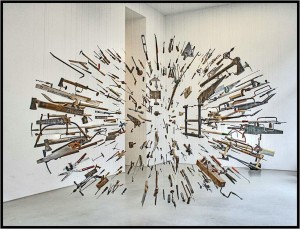
Displayed in art gallery. Damián Ortega, Controller of the Universe (2007, found tools and wire, dimensions vary). Collection of Glenn and Amanda Fuhrman, New York.
The Cooper Hewitt is filled with objects harboring this potential for dual identities. A relative of Duchamp’s snow shovel (functional identity)/In Advance of the Broken Arm (art identity) appears in Damián Ortega’s Controller of the Universe (2007) as one element in a starburst of tools through the axis of which visitors can wander. This central attraction of the design museum’s “Tools” floor makes a solo appearance in a room with white walls in a photo posted on the museum’s website.21 Reassembled to fit into an art gallery, this spatially condensed version transforms the viewers’ experience from active participation to passive contemplation of an esteemed work of art.
![Unidentified (French) artist, Salt Cellar with the Episodes from the Life of Hercules and Salt Cellar with Allegorical Scenes (c. 1550, enamel on copper, 2⅞ x 3 in [7.3 x 7.6 cm]). Harvard Art Museums, Cambridge, Massachusetts.](http://www.deborahfeller.com/news-and-views/wp-content/uploads/2015/06/Harvard-Salt-Cellar-Life-of-Hercules-painting-225x300.jpg)
Unidentified (French) artist, Salt Cellar with the Episodes from the Life of Hercules and Salt Cellar with Allegorical Scenes (c. 1550, enamel on copper, 2⅞ x 3 in [7.3 x 7.6 cm]). Harvard Art Museums, Cambridge, Massachusetts.
![Egmont Arons, designer, Meat Slicer (c. 1935, steel, 12½ x 17 x 20½ in [31.8 x 43.2 x 52.1 cm]) and Edo Period, Japan, Pothook Hanger (Jizai-Gake) (18th to 19th century, iron and wood, 18 x 16 x 4½ in [45.7 x 40.6 x 11.4 cm]). Brooklyn Museum of Art, New York.](http://www.deborahfeller.com/news-and-views/wp-content/uploads/2015/06/Meat-Slicer-and-Hook-BMA-225x300.jpg)
Egmont Arons, designer, Meat Slicer (c. 1935, steel, 12½ x 17 x 20½ in [31.8 x 43.2 x 52.1 cm]) and Edo Period, Japan, Pothook Hanger (Jizai-Gake) (18th to 19th century, iron and wood, 18 x 16 x 4½ in [45.7 x 40.6 x 11.4 cm]). Brooklyn Museum of Art, New York.
Visitors might be less inclined to regard the all-too-familiar deli appliance as art and feel similarly about the slicer’s neighbor, the large hook. Situate the much older, exotic Japanese piece in the Asian wing of any art museum, hang it on a wall under spotlighting and affix to the display a typical artwork label, and responses will likely change.
Ample evidence of this “museum effect–the tendency to isolate something from its world, to offer it up for attentive looking and thus to transform it into art like our own”22 exists in the University Collections Gallery of African Art at the Harvard Art Museums. There a select group of products from several countries in Africa, sparsely arranged in various shaped glass enclosures, hangs on the walls–a collection small enough in number for a single wall label to comfortably contain descriptions of all the pieces.
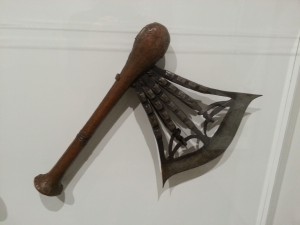
Axe, Songya, Democratic Republic of Congo (1914 or earlier, iron, copper and wood). Harvard Art Museums, Cambridge, Massachusetts
A stunningly beautiful axe, with a wooden handle and complex wrought iron head, shares its glass box frame with a less ornate companion, emitting conflicting messages about its identity. Everything about the setup, especially the segregation of the axes in their own display cases, emphasizes the uniqueness of each piece, connecting it with the art just seen in nearby galleries.
Shown in an exhibit hall at a natural history museum among many other examples of its type, these implements might be classified as artifacts, things that have “primarily the status of tools, of instruments or objects of use.”23 In a more inclusive definition, the dictionary describes them as “object[s] made by a human being, typically…of cultural or historical interest,”24 a category that can range from “sophisticated and culturally valuable artworks..to the smallest everyday thing.”25
The pool of opinion on what qualifies something as art teems with dangerous life forms, but the variables of “complex abstract thinking,”26 embodiment of a thought and expression of meaning,27 and evocation of emotions28 that include aesthetic delight,29 serve to classify most of them. While that last trait is both an unnecessary and insufficient determinant of artistic status, it can easily seduce observers into believing they are in the presence of real art (whatever that might be). Art museums, intentionally or not, often cash in on that response.
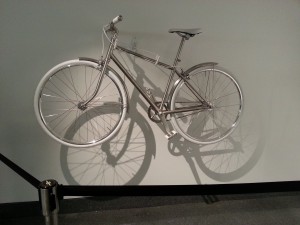
With barrier. Ai Weiwei, Untitled (2014, edition of 60, mixed media, primarily stainless steel). Brooklyn Museum of Art, New York.
On a wall near the ticket counter at the Brooklyn Museum of Art, a glittery silver city bike hangs behind a barrier, its artist Ai Weiwei having given it the noncommittal tag of Untitled. In the list of materials provided by either him or the museum–“mixed media, primarily stainless steel”30–the word bicycle is conspicuously absence, perhaps in hopes of enticing some unsuspecting bike-riding enthusiast, smitten by the beauty of the artifact glowing before her, to perceive the object as a work of art by world-famous Chinese artist Ai (as the label, lighting, ribbon barrier and placement on an art museum wall encourage) and part with the asking price of $27,500, an amount designed to offset the cost of the artist’s now past exhibition, Ai Weiwei: According to What?
Tooling around the city mounted on this splendid bike might turn it back into a “mere real thing,” diminishing its monetary though not aesthetic value. Hanging it back on a wall would restore its identity as art, the preference of any art collector (or curator). But for the rider, whose delight derives from speeding along on wheels, immobilizing such an exquisitely crafted bicycle would rob it of its raison d’être and, incidentally, extinguish the pleasure of exhibiting a prized possession in an arena markedly different from the interior of any art museum.
__________________________________
1 Justice Potter Stewart, Jacobellis v. Ohio, 378 U.S. 184 (1964), p. 197.
2 Anjan Chatterjee, The Aesthetic Brain: How We Evolved to Desire Beauty and Enjoy Art (New York: Oxford University Press, 2014.
3 Thierry de Duve, “‘This is Art’: Anatomy of a Sentence,” ArtForum, April 2014, 2.
4 Ably demonstrated in From Ancient to Modern: Archaeology and Aesthetics, an exhibition at the Institute for the Study of the Ancient World, February 12- June 7, 2015.
5 In 1914, Alfred Stieglitz mounted at his Gallery 291 “what he claimed to be the first exhibition anywhere to present African sculpture as fine art rather than ethnography.” See Modern Art and America: Alfred Stieglitz and his New York Galleries, National Gallery of Art, Washington DC. Accessed March 15, 2015, https://www.nga.gov/ exhibitions/modart_2.shtm.
6 Chatterjee, The Aesthetic Brain, 140.
7 Carol Duncan, “The Art Museum as Ritual,” Art Bulletin LXXVII, no. 1 (March 1995): 12.
8 Ivan Gaskell, “The Riddle of a Riddle,” Contemporary Aesthetics 6 (2008): 7.
9 Donald Preziosi, “Brain of the Earth’s Body: Museums and the Framing of Modernity,” in Museum Studies: An Anthology of Contexts, edited by Bettina Messias Carbonell (Malden, Massachusetts: Blackwell Publishing Ltd, 2004), 77.
10 Ibid., 78.
11 Boris Groys, Art Power (Cambridge, Massachusetts: The MIT Press, 2008), 38.
12 Duncan, 12.
13 E. H. Gombrich, “The Museum: Past, Present and Future,” Critical Inquiry 3, no. 3 (Spring 1977), 465.
14 Arthur C. Danto, “Artifact and Art,” in ART/artifact: African Art in Anthropology Collections (New York: The Center for African Art, 1988), 23.
15 Museum of Modern Art, catalog entry for In Advance of the Broken Arm. Accessed March 17, 2015. http://www.moma.org/learn/moma_learning/marcel-duchamp-in- advance-of-the-broken-arm-august-1964-fourth-version-after-lost-original-of-november-1915.
16 Groys, “On the New.”
17 “Art (play),” Wikipedia. Accessed March 19, 2015: http://en.wikipedia.org/wiki/ Art_(play).
18 Nelson Goodman, Ways of Worldmaking (Indianapolis, Indiana: Hackett Publishing Company, 1978), 66.
19 Ibid.
20 Object label, Radio Compass Loop Antenna Housing, Smithsonian Design Museum, Cooper Hewitt, New York.
21 “Controller of the Universe, 2007,” Cooper Hewitt website. Accessed March 19, 2015: https://collection.cooperhewitt.org/objects/35460745/.
22 Svetlana Alpers, “The Museum as a Way of Seeing” in Exhibiting Cultures: The Poetics and Politics of Museum Display, edited by Ivan Karp and Steven D. Lavine (Washington, DC: Smithsonian Institute, 1991), 27.
23 Google definition. Accessed March 19, 2015: https://www.google.com/ search?q=define:+arbiters+&ie=utf-8&oe=utf-8#q=define:+artifact.
24 Danto, “Artifact and Art,” 28.
25 Gaskell, “The Riddle of the Riddle,” 4.
26 Ibid.
27 Danto, “Artifact and Art,” 32.
28 Chatterjee, The Aesthetic Brain, 131.
29 E. H. Gombrich, “The Museum: Past, Present and Future,” 450.
30 Object label, Ai Weiwei, Untitled, Brooklyn Museum of Art, New York.



